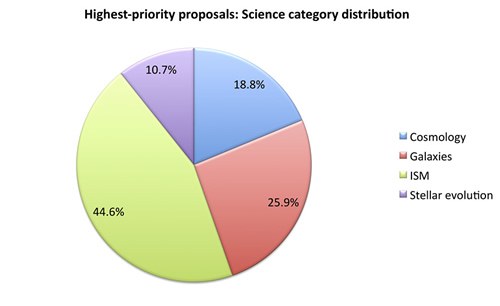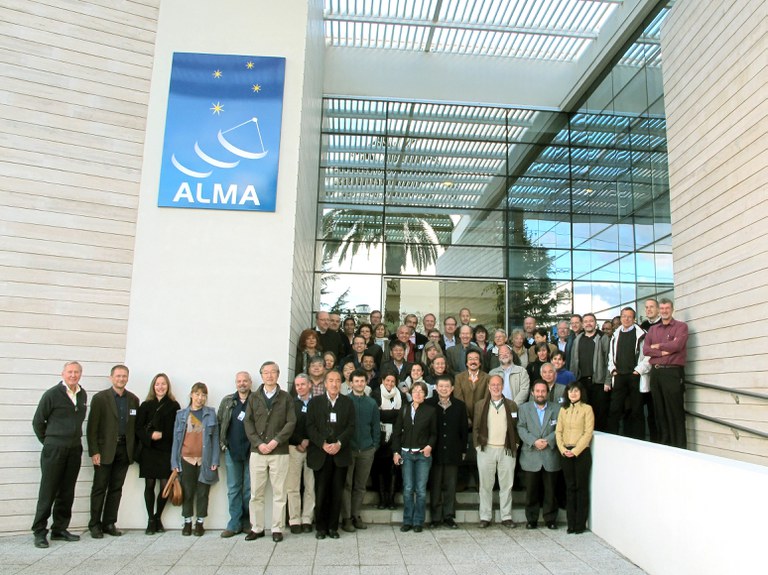Outcome of the proposal review process and a list of the highest priority Cycle 0 projects
The scientific and technical assessment of the 919 proposals submitted for ALMA Early Science Cycle 0 has been completed. Fifty science assessors and 25 technical assessors from all over the world have considered the expected scientific value and technical feasibility of the proposals submitted. As a result, the most promising proposals have been selected as those most likely for completion using the initial 16-antenna ALMA capabilities.
The 112 highest-priority projects (PDF available for download here) cover a wide range of science and are distributed across the four broad ALMA science categories as shown in the accompanying pie chart.

The observations to collect the data required to complete these projects are expected to start on 30 September or soon after. However, the construction and operation of ALMA - one of the world’s largest and most complex observatories, at an altitude higher than any other ongoing human activity - continues to be very challenging, and changes to the plan may still be necessary.
Principal Investigators (PIs) of the proposals will be notified of the outcome of the proposal review process by email.
The initial Phase II products will be generated by ALMA staff. PIs of highly rated proposals will be contacted by a scientist from their supporting ALMA Regional Centre (ARC) to review these Phase II products.

ALMA Cycle 0 science assessors in Vitacura, Chile, at the entrance to the ALMA Santiago Central Office building provided by ESO
ALMA would like to thank the 50 science assessors for their assistance in completing the scientific assessments of the Cycle 0 proposals, and to specially acknowledge the valued assistance of Neal Evans, Chair of the ALMA Proposal Review Committee (APRC), and Francoise Combes, Deputy Chair of the APRC.
|
APRC chair: |
|
|
Neal Evans |
The University of Texas at Austin (US) |
|
APRC and ALMA Review Panel (ARP) Members: |
|
|
Yuri Aikawa |
Kobe University (Japan) |
|
Rachel Akeson |
California Institute of Technology (US) |
|
Andrew Baker |
Rutgers, The State University of New Jersey (US) |
|
John Bally |
University of Colorado at Boulder (US) |
|
Beatriz Barbuy |
University of Sao Paulo (Brasil) |
|
Maite Beltran |
Arcetri Astrophysical Observatory (Italy) |
|
Jacqueline Bergeron |
Institut d'Astrophysique de Paris (France) |
|
Andrew Blain |
University of Leicester (UK) |
|
Dominique Bockelée-Morvan |
Paris Observatory (France) |
|
Leonardo Bronfman |
University of Chile (Chile) |
|
John Carpenter |
California Institute of Technology (US) |
|
Cecilia Ceccarelli |
Grenoble Observatory (France) |
|
Jose Cernicharo |
Centro de Astrobiología (Spain) |
|
Tracy Clarke |
Naval Research Laboratory (US) |
|
Françoise Combes |
Paris Observatory (France) |
|
Leen Decin |
Catholic University of Leuven (Belgium) |
|
Jayanne English |
University of Manitoba (Canada) |
|
Asunción Fuente |
National Astronomical Observatory (Spain) |
|
Yasuo Fukui |
Nagoya University (Japan) |
|
Gaspar Galaz |
Pontificia Universidad Católica de Chile (Chile) |
|
Guido Garay |
University of Chile (Chile) |
|
Jorma Harju |
Helsinki University (Finland) |
|
Naomi Hirano |
Academia Sinica Institute of Astronomy and Astrophysics (Taiwan) |
|
Leslie Hunt |
Arcetri Astrophysical Observatory (Italy) |
|
Frank Israel |
Leiden University (The Netherlands) |
|
Rob Ivison |
Royal Observatory, Edinburgh (UK) |
|
Hiroshi Karoji |
The University of Tokyo (Japan) |
|
Ryohei Kawabe |
National Astronomical Observatory of Japan |
|
Paulina Lira |
University of Chile (Chile) |
|
Dariusz Lis |
California Institute of Technology (US) |
|
Dieter Lutz |
Max-Planck-Institute for Extraterrestrial Physics (Germany) |
|
Tom Millar |
Queen's University Belfast (UK) |
|
Akira Mizuno |
Nagoya University (Japan) |
|
Raffaella Morganti |
Netherlands Institute for Radio Astronomy (The Netherlands) |
|
Neil Nagar |
University of Concepción (Chile) |
|
Sadanori Okamura |
The University of Tokyo (Japan) |
|
Hans Olofsson |
Chalmers University of Technology (Sweden) |
|
Takashi Onaka |
The University of Tokyo (Japan) |
|
Ilaria Pascucci |
University of Arizona (US) |
|
Alexandra Pope |
University of Massachusetts at Amherst (US) |
|
Luis Felipe Rodriguez |
National Autonomous University of Mexico |
|
Dave Sanders |
University of Hawaii at Manoa (US) |
|
Nick Scoville |
California Institute of Technology (US) |
|
Debra Shepherd |
National Radio Astronomy Observatory, Socorro, NM (US) |
|
Lister Staveley-Smith |
International Centre for Radio Astronomy Research (Australia) |
|
Yoshiaki Taniguchi |
Ehime University (Japan) |
|
Masato Tsuboi |
Institute of Space and Astronautical Science (Japan) |
|
Dave Wilner |
Harvard-Smithsonian Center for Astrophysics (US) |
|
Christine Wilson |
McMaster University (Canada) |
